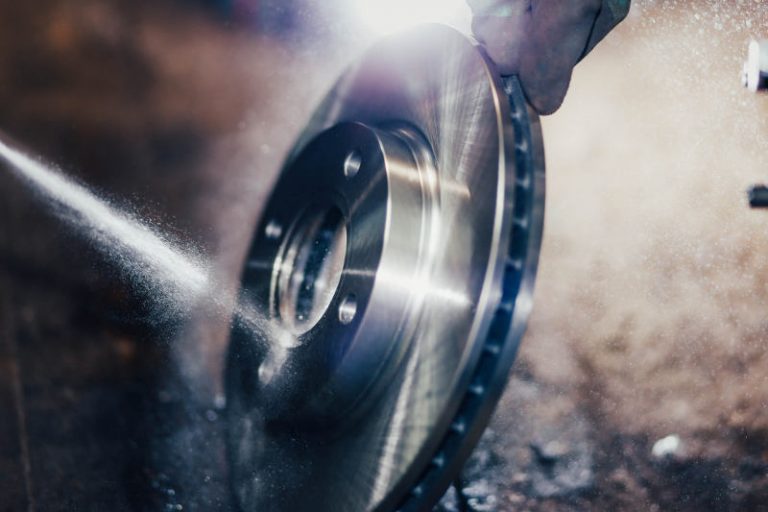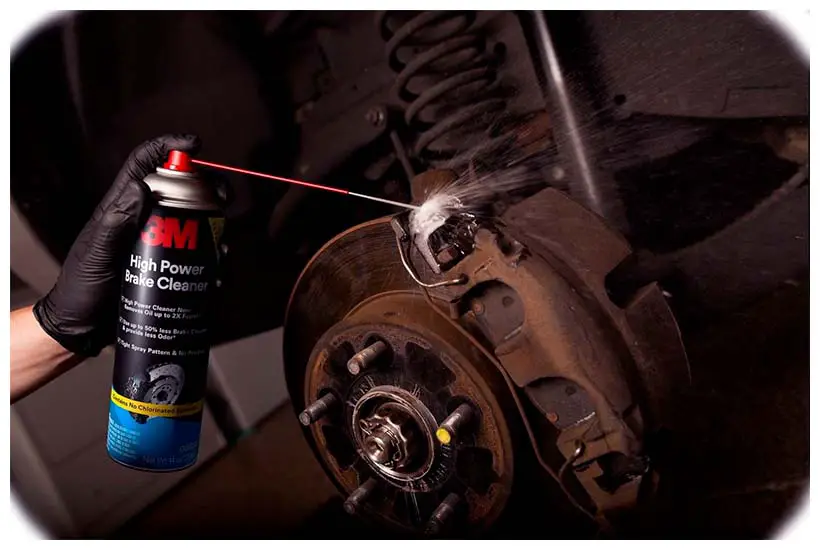Does brake cleaner leave a residue? Brake cleaner is designed to evaporate quickly and leave no residue on brake components. However, the formation of residue can occur depending on factors such as the type of cleaner, application method, and environmental conditions.
Brake cleaner is an essential tool for mechanics and car enthusiasts alike, commonly used to clean brake components such as discs, drums, pads, and calipers. Its primary function is to remove oils, grease, dust, and contaminants that could negatively affect brake performance. However, a question often arises: does brake cleaner leave a residue? Knowing this is important, as residue can impair brake performance, leaving a greasy or sticky layer that can attract more dust or debris.
In this blog post, we will explore this question in depth, providing insights into the different types of brake cleaners, the factors influencing residue formation, and the steps you can take to ensure a clean and residue-free surface after cleaning.

Contents
What Is Brake Cleaner?
Brake cleaner is a solvent-based product designed to remove contaminants from the brake system. It is formulated to clean without leaving a residue, allowing for improved brake performance and efficiency. Brake cleaners typically come in aerosol cans, making it easy to spray directly onto brake components. The primary contaminants targeted by brake cleaners are grease, dust, oil, and brake fluid.
Types of Brake Cleaners
There are primarily two types of brake cleaners on the market: chlorinated and non-chlorinated. Both are designed to perform the same basic function, but they differ in terms of their chemical composition and environmental impact.
- Chlorinated Brake Cleaners: These contain solvents such as methylene chloride or tetrachloroethylene. They are highly effective at cleaning and evaporate quickly, leaving little to no residue. However, chlorinated brake cleaners are becoming less popular due to their environmental and health concerns. In some regions, they are being phased out in favor of more eco-friendly options.
- Non-Chlorinated Brake Cleaners: These use solvents such as acetone, heptane, or isopropyl alcohol. They are flammable and generally safer for the environment. Non-chlorinated brake cleaners also dry quickly, and while they are effective at cleaning, they may leave a residue in certain conditions if not applied properly.
Does Brake Cleaner Leave a Residue?
The short answer to this question is no, brake cleaner is designed to evaporate quickly, leaving no residue. However, as with most products, the outcome can depend on various factors such as the type of brake cleaner used, the application technique, and the environmental conditions. Let’s break down each of these factors to understand better why residue might form or not.
Types of Brake Cleaners and Their Residue
As mentioned, brake cleaners come in two primary types: chlorinated and non-chlorinated.
- Chlorinated Brake Cleaners: These are less likely to leave residue because they contain highly volatile solvents that evaporate quickly. Chlorinated cleaners are typically used in professional settings due to their superior cleaning power. They are ideal for cleaning metals and do not usually leave behind any film or grease after evaporation.
- Non-Chlorinated Brake Cleaners: While non-chlorinated cleaners are more environmentally friendly, they can sometimes leave a small amount of residue, especially if used incorrectly. This is because they are not as volatile as their chlorinated counterparts, and environmental factors such as humidity can slow down evaporation. If not applied carefully, non-chlorinated cleaners may leave behind small traces of solvent or contaminants.
Factors That Influence Residue Formation
When using brake cleaner, several factors can impact whether residue is left behind. Understanding these elements can help ensure proper application and prevent residue from interfering with brake performance.
Application Method
The way you apply brake cleaner plays a significant role in whether residue will be left behind. If brake cleaner is applied from a close distance or in excess, it may not evaporate completely before it settles, leading to residue. Always apply brake cleaner from a distance of about 6-12 inches and allow it time to evaporate naturally. Spraying in short bursts helps prevent over-application, which can slow the drying process.
Environmental Conditions
Weather conditions, especially temperature and humidity, can affect the evaporation rate of brake cleaners. High humidity or cold temperatures can slow down the evaporation process, allowing the cleaner to linger on the surface and potentially leave behind a residue. On the other hand, applying brake cleaner in a dry, warm environment will allow it to evaporate faster and leave no residue.
Material Compatibility
Brake cleaner is typically safe for use on metals, but using it on sensitive surfaces, such as plastics or rubber, can lead to residue or damage. It is essential to use brake cleaner that is compatible with the materials you are cleaning. Always check the manufacturer’s recommendations before use.
Can Residue Be Prevented?
Although high-quality brake cleaners are designed to leave no residue, improper use can lead to residue formation. Here are some tips to ensure that brake cleaner leaves no residue:
1. Choose the Right Cleaner
Select a brake cleaner that suits your needs. If you’re working in a well-ventilated area, chlorinated brake cleaners are a great option as they evaporate quickly and leave no residue. However, if you’re concerned about the environment, non-chlorinated brake cleaners are a safer choice, although they might require more care during application.
2. Apply Correctly
Spray the cleaner from a recommended distance, typically between 6 to 12 inches. This ensures that the cleaner has enough time to evaporate before settling on the surface. Avoid over-applying, as this can lead to excess solvent that may not evaporate completely.
3. Allow Sufficient Drying Time
After applying brake cleaner, give it enough time to dry. It’s crucial to allow the cleaner to evaporate fully, especially in high-humidity environments. Avoid using compressed air to speed up the process, as this may cause the solvent to spread unevenly, leaving a film behind.
4. Use in the Right Conditions
Ideal conditions for applying brake cleaner include moderate temperatures and low humidity. If you’re working in a high-humidity environment, it may be best to allow the cleaned parts to air dry naturally.
5. Wipe the Parts After Cleaning
In some cases, it may help to wipe the cleaned components with a lint-free cloth to remove any excess cleaner or to ensure no residue remains.

Why Is It Important That Brake Cleaner Leaves No Residue?
Brake cleaners are designed to remove oils, grease, and other contaminants from the brake components. Any residue left behind could:
- Impede Brake Functionality: Residue on brake components can interfere with their performance, leading to poor braking response or even brake failure. Brake pads and rotors should remain free from any contaminants that could affect their frictional properties.
- Attract More Dirt: A greasy or sticky residue can attract dirt, dust, and debris, which may lead to further contamination of the brake components. This can result in faster wear and tear of parts and decrease the overall lifespan of the braking system.
- Damage Sensitive Components: Some brake cleaners, if not used correctly, can damage sensitive parts like rubber seals, paint, or plastic components. Residue left on these parts may degrade the material over time.
Frequently Asked Questions
Here are some FAQs about brake cleaner leaving a residue –
1. Does brake cleaner damage rubber components?
Some brake cleaners can damage rubber seals or parts, especially if they are not compatible. Always check the product label to ensure compatibility with rubber.
2. What happens if brake cleaner leaves residue?
If brake cleaner leaves residue, it can affect brake performance by attracting dirt, interfering with braking efficiency, or damaging components.
3. Can I use brake cleaner on painted surfaces?
Brake cleaners can damage paint, especially if it is not designed for use on painted surfaces. It’s recommended to avoid contact with painted parts.
4. How can I avoid brake cleaner residue?
Apply the cleaner from a distance, allow sufficient drying time, and use in ideal environmental conditions to avoid residue.
5. Are there eco-friendly brake cleaners?
Yes, many manufacturers offer non-chlorinated and biodegradable brake cleaners that are safer for the environment and less toxic.
Conclusion
In conclusion, brake cleaners are formulated to evaporate quickly without leaving any residue, making them effective for cleaning brake components. However, factors such as the type of brake cleaner, application method, and environmental conditions can influence whether or not residue is left behind. By choosing the right cleaner, applying it correctly, and allowing it to dry in optimal conditions, you can ensure that your brake components are cleaned thoroughly without any unwanted residue.
Brake cleaners are a vital tool for anyone maintaining a vehicle, and understanding how to use them properly is essential for keeping your braking system in top condition.